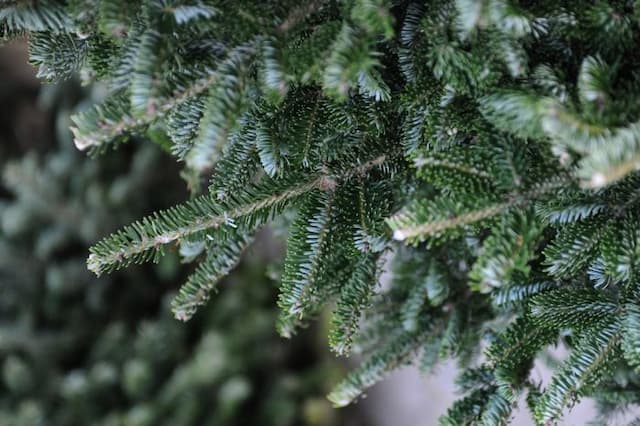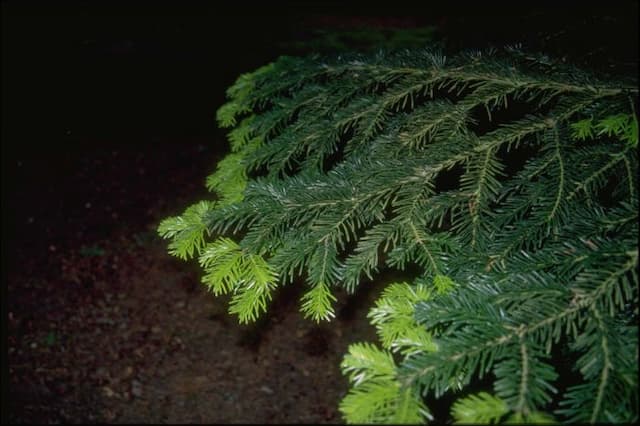Picea asperata

ABOUT
Picea asperata, commonly known as the Dragon Spruce, is a coniferous evergreen tree characterized by its unique and striking appearance. It has a traditional Christmas tree shape with a conical crown and a straight trunk. The needles of the Dragon Spruce are typically a fresh green color, although they can vary and may sometimes appear more blue-green. They are arranged radially around the branches, and each needle has a somewhat stiff and sharp texture, which can be prickly to the touch. The bark of the Dragon Spruce is another distinctive feature, often presenting a rugged and flaky texture. Over time, the bark can transform from a smooth, grayish-brown in younger trees to a more rugged and darker shade as the tree matures. This gives the tree an aged and weathered look, which adds to its majestic presence. The branches of the Dragon Spruce grow horizontally out from the trunk and are usually densely covered with needles. This dense foliage provides a thick canopy, which can create a lush and full appearance. During the reproductive period, it is adorned with cones that have a classic elongated shape. These cones usually display a woody texture and can have a color palette ranging from green to a mature brown, depending on their age. Overall, the Dragon Spruce is a robust and hardy tree that exudes a sense of endurance and vitality. Its evergreen nature ensures that it is a tree of remarkable beauty throughout the year, making it a favorite for landscaping and ornamental purposes. However, it is important to note that the Dragon Spruce does not lend itself well to indoor cultivation due to its need for a specific climate and growing conditions.
About this plant
 Names
NamesFamily
Pinaceae.
Synonyms
Dragon Spruce.
Common names
Picea brachytyla, Picea polita, Picea retroflexa, Picea sitchensis var. polita, Picea wilsonii.
 Toxicity
ToxicityTo humans
The plant known as Picea asperata, more commonly referred to as Dragon spruce, is not typically known for being toxic to humans. There is no widespread or common documentation of toxicity in humans from handling or ingesting parts of the Dragon spruce. As with many plants, individuals with specific allergies may have reactions, but for the general population, this species does not present a significant risk of poisoning or toxicity from casual contact or ingestion.
To pets
Dragon spruce (Picea asperata) is not commonly listed as a toxic plant to pets, such as dogs and cats. Thus, ingestion of this plant is not typically associated with a risk of severe poisoning. However, it's worth noting that non-toxic plants can still cause gastrointestinal discomfort in pets if ingested in large amounts, or if the pet has a sensitivity to the plant. Signs might include vomiting or diarrhea. Serious consequences are rare, but if you notice any signs of illness in your pet after ingestion of any plant material, it's wise to consult a veterinarian.
 Characteristics
CharacteristicsLife cycle
Perennials
Foliage type
Evergreen
Color of leaves
Green
Height
60 feet (18 meters)
Spread
20 feet (6 meters)
Plant type
Tree
Hardiness zones
6
Native area
China
Benefits
 General Benefits
General Benefits- Ecosystem support: Picea asperata, also known as the Dragon Spruce, plays a crucial role in mountain ecosystems by providing habitats for various species of wildlife.
- Soil stability: The extensive root system of the Dragon Spruce helps prevent soil erosion, especially in sloped areas where this can be a critical issue.
- Climate regulation: Like other tree species, Dragon Spruce contributes to climate moderation through carbon sequestration, thus helping to mitigate the effects of global warming.
- Wood production: The timber of Dragon Spruce is valued for construction and as material for furniture and other wood products.
- Ornamental use: Due to its aesthetic appeal, Dragon Spruce is often used in landscaping and as a decorative element in gardens and parks.
- Shade and cooling: Dragon Spruce trees provide natural shade and cooling properties which are beneficial for reducing local temperatures and creating comfortable outdoor spaces.
- Recreational space: Forests of Dragon Spruce offer recreational opportunities for activities such as hiking, bird watching, and nature photography, fostering a connection with nature.
 Medical Properties
Medical Properties- Antimicrobial: Picea asperata extracts may possess antimicrobial properties that help inhibit the growth of certain bacteria and fungi.
- Anti-inflammatory: The plant contains compounds that could potentially reduce inflammation and alleviate inflammatory conditions.
- Analgesic: There may be analgesic compounds present in the plant that can help relieve pain.
- Antioxidant: The presence of antioxidant compounds in Picea asperata may help protect cells from oxidative stress and damage.
 Air-purifying Qualities
Air-purifying QualitiesThis plant is not specifically known for air purifying qualities.
 Other Uses
Other Uses- Picea asperata, commonly known as Dragon Spruce, has been used in musical instrument construction; its resonant wood qualities make it suitable for making soundboards in instruments like violins and pianos.
- The wood of Dragon Spruce is sought after for crafting fine furniture due to its durability and aesthetically pleasing grain patterns.
- In landscape architecture, Dragon Spruce is used as a focal point in garden design for its distinctive pyramidal shape and attractive evergreen foliage.
- The wood fibers of Dragon Spruce can be processed into a pulp for producing high-quality paper products, including artist-grade paper.
- Dragon Spruce can be used in woodworking for making decorative objects and intricate carvings, showcasing the wood's fine grain and workability.
- Dragon Spruce resins are sometimes harvested for use in varnishes and adhesives, thanks to their sticky and waterproofing properties.
- The aromatic properties of Dragon Spruce needles make them a natural choice for creating scented products such as potpourris and essential oils.
- In some cultures, the branches and needles of Dragon Spruce are used in traditional ceremonies or festive decorations during holidays like Christmas.
- Because of its slow-burning characteristics, Dragon Spruce wood is utilized for smoking foods to impart a distinct flavor.
- Dragon Spruce sawdust and wood shavings are incorporated into composts and mulches to enrich soil and provide plant nutrients.
Interesting Facts
 Feng Shui
Feng ShuiThe Dragon spruce is not used in Feng Shui practice.
 Zodiac Sign Compitability
Zodiac Sign CompitabilityThe Dragon spruce is not used in astrology practice.
 Plant Symbolism
Plant Symbolism- Resilience and Strength - Picea asperata, commonly known as Dragon Spruce, often grows in rocky and harsh environments, symbolizing the ability to thrive despite challenging conditions.
- Longevity - Dragon Spruces can live for hundreds of years, representing endurance and the passage of time.
- Protection - In folklore, spruce trees are often seen as protective symbols, guarding against negative energies and providing a safe haven.
- Purity and Cleansing - The evergreen nature of the Dragon Spruce suggests themes of purification and renewal, as it stays green throughout the year.
- Healing - Spruce trees are sometimes associated with medicinal properties and healing, both in physical and spiritual senses.
 Water
WaterDragon Spruce should be watered deeply to ensure the soil is moist throughout the root zone, which typically requires a few gallons of water. The frequency of watering depends on the climate and the season, but generally, watering every week during dry periods is sufficient. In less arid climates, or during the rainy season, watering may be reduced. It’s crucial to avoid overwatering, as this can lead to root rot. Make sure to provide enough water to soak the root area without allowing the roots to sit in standing water.
 Light
LightDragon Spruce thrives in full sun conditions but can tolerate partial shade. The best spot for this plant is an area where it can receive at least six hours of direct sunlight each day. It's especially important that the tree has adequate light if it is to develop its characteristic conical shape and dense foliage.
 Temperature
TemperatureDragon Spruce prefers cooler temperatures and is well-suited for colder climates with temperatures ranging from 20°F to 70°F. They can endure seasonal extremes, surviving short periods as low as -30°F and as high as 80°F. The ideal temperature range for optimal growth is between 50°F and 60°F.
 Pruning
PruningPrune Dragon Spruce to maintain its shape and health, removing any dead or diseased branches. The best time to prune is late winter or early spring just before new growth begins. Pruning can be done annually, but full pruning may not be necessary every year; sometimes light trimming is all that's needed to remove irregular growth.
 Cleaning
CleaningNot needed
 Soil
SoilThe best soil mix for Dragon Spruce (Picea asperata) is well-draining, with a mix of peat, sand, and organic matter; it prefers a slightly acidic to neutral pH of 5.5 to 7.0.
 Repotting
RepottingDragon Spruce (Picea asperata) typically requires repotting every 2-3 years; repot less frequently as the tree matures.
 Humidity & Misting
Humidity & MistingDragon Spruce (Picea asperata) thrives best in moderate to high humidity, aiming for a level of 40-60%.
 Suitable locations
Suitable locationsIndoor
Ensure bright light, cool temps, and good air circulation for Dragon Spruce.
Outdoor
Place in full sun to partial shade with moist soil for Dragon Spruce.
Hardiness zone
6-8 USDA
 Life cycle
Life cycleThe life cycle of Picea asperata, commonly known as Dragon Spruce, begins with seed germination, which occurs in the spring after the winged seeds disperse from the cones. Once germinated, the seedlings develop into young saplings, establishing a root system and beginning vertical growth. As the saplings mature into juvenile trees, they undergo a period of rapid growth, developing a characteristic conical shape and producing their first cones after 5-10 years. The adult Dragon Spruce then enters its reproductive phase, producing male and female cones; the female cones carry the seeds, which mature and are then released to start a new generation. The mature Dragon Spruce can live for several hundred years, during which it continues to grow in height and girth, and experiences periodic cone production and seed dispersal. The cycle concludes as the tree eventually senesces and dies, decomposing to nourish the forest soil, and thus supporting the growth of new plants.
 Propogation
PropogationPropogation time
Late winter-early spring
The most popular method of propagation for Picea asperata, commonly known as the Dragon spruce, is by seed. The best time for sowing the seeds is typically in late winter to early spring to coincide with their natural germination period. The seeds should first be stratified, which involves simulating winter conditions to break dormancy by keeping them cold, usually around 34-41 degrees Fahrenheit (1-5 degrees Celsius), for a period of 3-4 weeks. After stratification, the seeds are sown in moist, well-draining seed starting mix, lightly covered with soil, and kept at temperatures of around 68 degrees Fahrenheit (20 degrees Celsius) to encourage germination. It is essential to maintain consistent moisture but avoid waterlogging until sprouts appear, which can take several weeks. Once the seedlings are strong enough, they can be transplanted into individual pots or directly outdoors, depending on weather conditions and the size of the seedlings.








